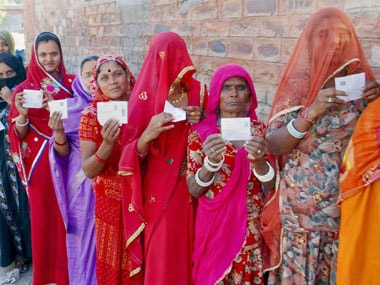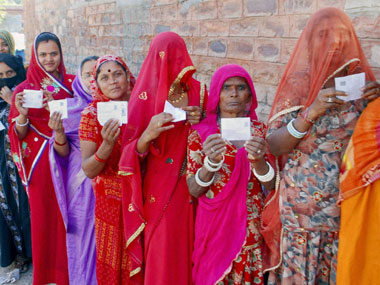On the Indian festival of Karva Chauth in October, perhaps in consonance with the spirit of the occasion, Rajput women saved the dignity and honor of leaders of their community in Rajasthan. Rajput organisations led by Lokendra Singh Kalvi, the burly leader from western Rajasthan who spearheaded the campaign for a ban on Sanjay Leela Bhansali’s Padmaavat, were expecting a gathering of at least a lakh in response to their call for showcasing their electoral strength. But just a few dozen women, mainly relatives of the leaders, reached the venue to fill up a few seats in a completely empty ground in Jaipur. [caption id=“attachment_1260755” align=“alignleft” width=“380”]  File photo of women waiting to cast their votes in Rajasthan. PTI[/caption] As the Rajputs and their women, dressed in traditional lehngas (long skirts) and colorful odhnis (shawls), brandished swords on the stage and shouted feeble slogans on the ground, their display of bravado and strength appeared to be a tragi-comic denouement of the campaign the Rajputs had been leading to assert their identity. Rajputs have been on the warpath in Rajasthan on two emotive issues that may sound preposterous to observers outside the state. For almost two years, they have been sulking over their inability to get Padmaavat—a film based on a fictional account of a Rajput princess—banned. And since June 2017, they have been angry over the encounter killing of Anand Pal Singh, a fugitive considered a hero by many Rajput youth. Padmaavat has come and gone. Some of its wounds have healed because Rajputs managed a token victory by not allowing theatres to screen the film in Rajasthan and a few adjoining states. But the ghost of the gangster continues to haunt the community and the state’s electoral politics. Anand Pal Singh was gunned down by a three teams from Rajasthan and Haryana police in Malasar village of Churu district on 24 June. His encounter led to violent protests among Rajputs and accusations of cold-blooded murder against the police. In the aftermath, several cases were filed against his followers in many police stations. Since his death, Anand Pal has turned into a Robin Hood-esque figure for the community, a symbol of both pride and affection. His followers believe he helped hundreds of Rajput families and helped reestablish their clout on the ground by competing ferociously with their traditional rivals the Jats. “Rajputs are extremely angry with the BJP because of Anand Pal’s encounter and the subsequent harassment of many Rajput families through police cases. They have decided to teach the BJP a lesson,” said Pratap Singh Khachariawas, a prominent Rajput leader and nephew of former vice-president Bhairon Singh Shekhawat, a BJP stalwart. Many other community leaders echo his sentiments and openly vow to defeat the BJP in the Assembly elections scheduled for December. Rajput leader Giriraj Singh Lotwara said there is widespread resentment because of the encounter and the spate of cases that have destroyed many families. “We nurtured the BJP. It has now turned against us,” he argued. For many years, Rajputs were considered the BJP’s vote bank. This was primarily because the Congress was supported by Jats, who are seen as the community’s rivals, and because for decades the BJP was led by Shekhawat, the community’s idol, and prominent members of erstwhile royal families. Since his demise, Rajputs have felt marginalised by the BJP. This alienation and resentment has increased because the BJP under Vasundhara Raje has made grand overtures of friendship towards Jats, who are electorally more powerful than Rajputs. Some suspect stoking Rajput anger is part of the BJP’s strategy to distance itself from the community and, thus, snare the Jats into its fold. This theory is buttressed by the first list of candidates released by the BJP for Rajasthan earlier this week, which has 26 Jats compared to 17 Rajputs, a clear indication of the party’s preferences. BJP insiders believe Rajput anger would lead to counter-polarisation among Jats who are not just more in numbers but have far greater resources. On paper, this appears to be a fail-safe strategy. But, Jats are politically very sharp and are known to support the party that is most likely to win an election. If the BJP fails to emerge as a front-runner, Jats might desert the party and combined with the exodus of Rajputs inflict a deadly blow to Raje’s fortunes. There are 10 to 15 thousand Rajput voters in almost every constituency of Rajasthan. In western Rajasthan, they are a formidable electoral force because of higher concentration. The community also has the ability to work closely with smaller communities. In a close election, their loyalty could be decisive in at least three dozen constituencies in the 200-member Assembly. Aware of their electoral strength, Rajputs are now trying to rally behind Anand Pal’s wife Nirmal Kanwar, who, it is rumored, may contest either as an Independent candidate or with the support of BJP’s rivals from Ladnun, the gangster’s home turf.
In a close election, their loyalty could be decisive in at least three dozen constituencies in Rajasthan’s 200-seat Assembly.
Advertisement
End of Article


)
)
)
)
)
)
)
)
)



